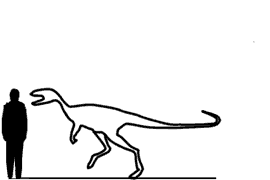[Recent Entries][Archive][Friends][User Info]
| March 16th, 2012 | |
|---|---|
| 06:41 pm [industrialterro] [Link] |
Chindesaurus Chindesaurus bryansmalli — ископаемый вид ящеротазовых динозавров, живших в позднем триасе около 216 млн лет назад на территории США. Находки были сделаны в штате Аризона. В настоящее время точное таксономическое положение динозавра не определено, из-за фрагментарного характера его останков. Предполагается, что он относится к кладе Herrerasauridae. Если это действительно так, то он является самым поздним представителем данной группы. Chindesaurus is known from five incomplete specimens (six if Caseosaurus is included). The type specimen is the most complete, and contains several rib and vertebrae fragments, two complete vertebrae from the hips and one from the tail, fragments of hip bones, and partial leg bones. A single tooth was also found with the specimen. The remaining specimens are even more incomplete, consisting of isolated hip bones and upper leg bones (femora), and more vertebrae. The type and paratype specimens probably came from individuals around 2.4 metres (7.9 ft) in length. Chindesaurus has been difficult to classify, and has been recovered in several different positions at the base of the saurischian family tree. When it was first discovered in 1985, the animal which would eventually be named Chindesaurus was thought to be a prosauropod. When it was finally described and named a decade after its discovery by Long and Murry, they regarded it as a herrerasaurid, an opinion that has been followed by most paleontologists since. Phylogenetic analyses published through 2007 continued to find it to fall among the herrerasaurids, though a few studies cast doubt on this, including one in 2007 by Irmis, Nesbitt and colleagues which found Chindesaurus to be a probable basal saurischian dinosaur, and noted that it shares a wide range of characteristics with several lineages of basal saurischians, making any classification problematic. One specimen originally assigned to Chindesaurus, from the Tecovas Formation of Texas, was later placed in its own genus and species, Caseosaurus crosbyensis. Subsequent research has shown that this separation was probably in error, and that the two forms represent the same species. Nesbitt, Irmis and Parker agreed in a 2007 paper that there is little reason to separate Caseosaurus from Chindesaurus, and the two even share some unique characteristics not found in similar species. Nesbitt and colleagues suggested that any differences between the two were probably related to differences in size. However, since both species are so fragmentary, they decided not to formally make them synonyms.
Размеры тела в сравнении с человеком:
Ископаемые останки (1, 2, 3, 4):
Tags: Вымершие рептилии, Триас, авеметатарзалии, архозавроморфы, архозавры, диапсиды, динозавроморфы, динозавры, ящеротазовые |





